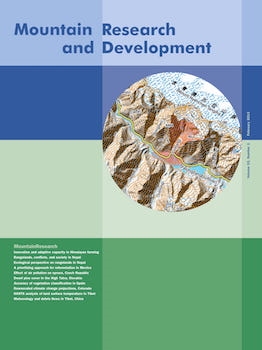Dear Readers,
As we were concluding preparation of this issue for publication, we learned that Martin Price—Director of the Centre for Mountain Studies, Perth College, University of the Highlands and Islands, and MRD's MountainMedia Editor since 1994—was awarded the golden King Albert Mountain Award for decisive achievements in the mountain world. The laudation for the award commends Professor Price's work with international organizations, his role as the organizer of international mountain conferences, and his work as a writer and editor of mountain publications. We are most grateful to count him among MRD's Editorial Team and congratulate him on receiving this distinction. By coincidence, the article in this issue's MountainPlatform section presents Martin's institution's recent achievements in the field of sustainable mountain development; and the issue concludes with 5 book reviews emerging from his activity as MountainMedia Editor. Without the dedicated work of experts like Martin Price and all the reviewers of articles submitted to the journal, MRD would not be able to serve its authors and readers in the way it does. We would like to thank them all for their commitment to ensuring the high-quality of work on mountains and mountain development that we are able to publish.
The 10 peer-reviewed papers in this Open Issue are all in the MountainResearch section and present “systems knowledge” of relevance to sustainable development in the Himalayas, Central Mexican range, Southeast European mountains, Pyrenees, Rocky Mountains, and Tibetan Plateau. In the first article, Tor Aase, Prem Chapagain, and Prakash Tiwari compare 2 Himalayan hill villages in India and Nepal, and explore what hampers or boosts these communities' ability to adapt to change and continue to contribute to food production; the value of this study lies in its integrated approach to innovation generation. In the second paper, Achyut Aryal and co-authors focus on the much higher Himalayan rangelands situated in the Mustang district of Nepal: their extensive analysis of a prolonged conflict over the use of rangeland by 2 villages reveals how complex it is to find solutions when stakeholders refer to competing and incompatible institutional frameworks. The basis for more sustainable rangeland management in Nepal is also the focus of the article by Khem Bhattarai and Thakur Upadhyay: in their ecological study, they show that total available fodder biomass in the Sagarmatha National Park has not been fully utilized yet and higher stocking rates would be advantageous to biodiversity, though not as the only measure, since wild ungulates also benefit from available fodder.
The status of mountain forests is the focus of the next 4 articles, 2 of which offer enhanced methodological approaches. Driven by their desire to support more cost-effective decisions regarding reforestation measures in Central Mexico, Gustavo Cruz-Bello and Erasto Sotelo-Ruiz propose a new geospatial decision-making tool to identify suitable areas for restoration. In the next paper, Stanislav Vacek and co-authors analyze the effect of local air pollution on the health status of spruce stands in a case study in the Krkonoše Mountains, Czech Republic; even now, they conclude, air pollution in the Sudeten represents a serious hazard for the forest ecosystem. As a contribution to monitoring the impacts of climate change in European mountains, Jaroslav Solár and Marián Janiga analyze the response of dwarf pine distribution to selected abiotic habitat conditions in the eastern Tatra Mountains, Slovakia. Maite Gartzia and co-authors devote their article to presenting an improved method for classifying vegetation in mountains, illustrating this with a case study of forest landscapes in the Spanish Central Pyrenees.
The last 3 papers in the MountainResearch section focus on climatic aspects and conditions in mountains. C. Andrew Day proposes a method for statistical downscaling of climate change projections in a comparatively small river basin in Colorado, USA, with the ultimate aim of improving water resource management in such basins, where large-scale projections are not really suitable. Yongming Xu, Yan Shen, and Ziyue Wu also propose a methodological innovation: using a harmonic analysis of time series (HANTS) algorithm, they try to tackle the task of assessing spatial and temporal variations of land surface temperature—a key factor in energy and water transfers—on the Tibetan Plateau, an area where remoteness makes data collection very difficult. In the final paper, Jiankang Liu, Zunlan Cheng, and Qinghui Li analyze the relationship between weather and debris flows from Guxiang Glacier, a typical maritime glacier in Tibet, in order to better predict potential threats to an important road in the valley that runs south of the glacier.
We hope that readers will appreciate and benefit from these results of research conducted in mountains worldwide.





